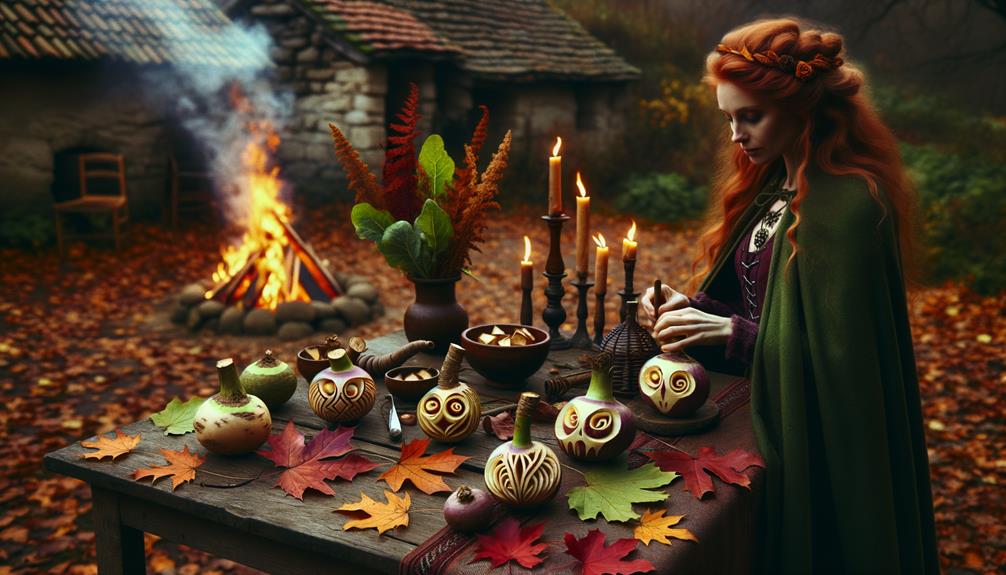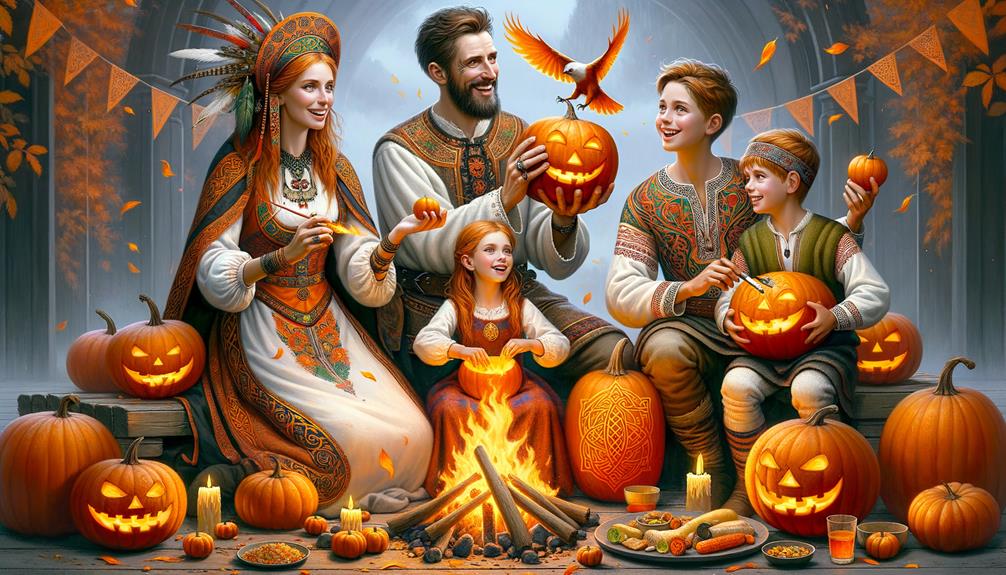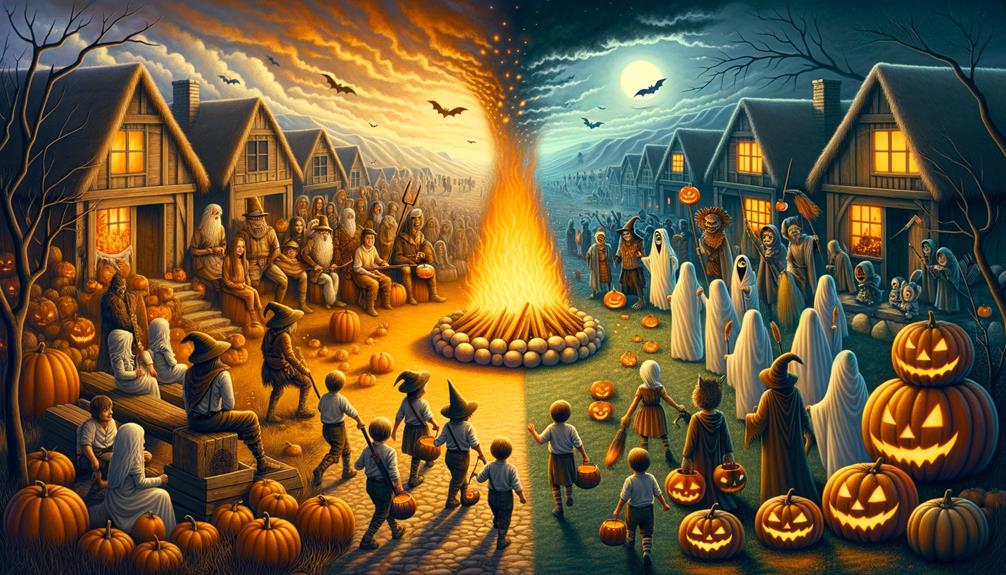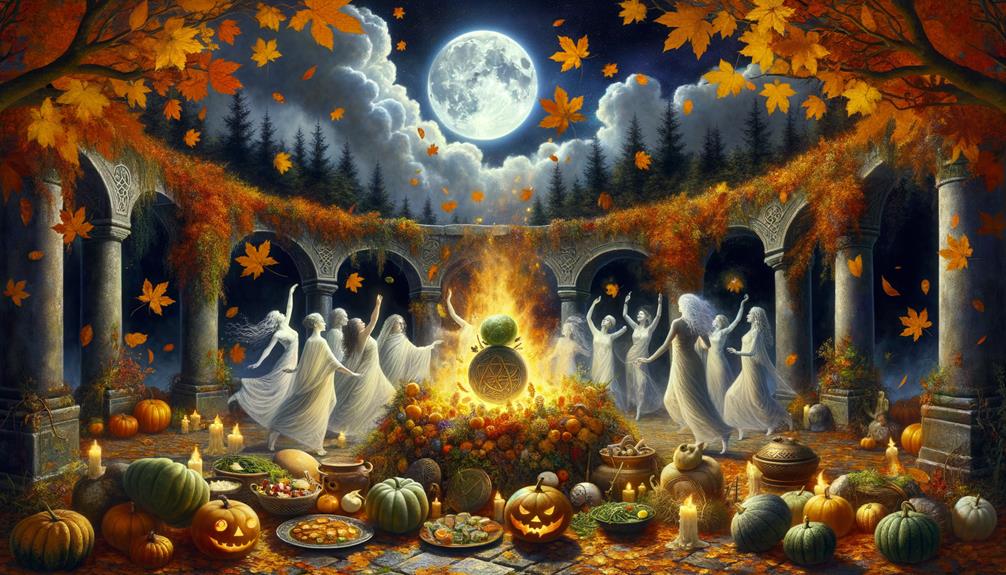The lore of Celtic mythology, like the wisdom-laden sacred well of the ancient druids, has always caught my interest. The Samhain festival, celebrated at the onset of winter, is particularly enchanting. It's brimming with deep symbolism and mystique, serving as a bridge between our world and the spectral one. The practices, from wearing disguises to fend off spirits to predicting the future, blend fear, respect, and awe for the unseen. But, these customs aren't just dusty relics of the past; they've evolved and continue to do so, influenced by modern practices. So, what's the real meaning of these Samhain traditions, and how have they trickled into today's festivities? You'll find the answers as intriguing as the festival itself.
Origins of Samhain Festival

Let's take a journey back in time to the roots of the Samhain festival. You'll find that this event is deeply intertwined with ancient Celtic spiritual customs. It signifies the shift into the darker part of the year. The festival first emerged as a pagan religious celebration in Ireland and is observed from the end of October until the beginning of November, marking the end of the harvest season.
Interestingly, Samhain was the most noteworthy of the four cyclical fire festivals in ancient Celtic tradition. During this ritual, all household fires would be put out. Then, the Druid priests would light a communal flame using a wheel, a symbol representing the cycle of the seasons.
But Samhain was more than just a party. It held deep spiritual meanings. People believed that during this time, the lines separating the physical and spirit worlds would become less distinct, allowing for encounters between humans and supernatural entities. These beliefs were expressed through prayers, igniting bonfires, and making sacrifices.
As the years rolled on, this ancient Celtic festival transformed into what we know today as Halloween. Yet, it still retains some of its original elements, like costume parties, trick-or-treating, and bonfires. So, Samhain continues to serve as an intriguing reminder of how ancient spiritual traditions can influence our modern customs.
Traditional Samhain Customs

Diving into the rich history of ancient Celtic traditions, Samhain customs held a deep, spiritual importance, mixing tangible preparations with metaphysical beliefs. This Celtic festival, which lasted three days, represented a period when the barriers of the spiritual realm became more porous, creating a unique moment in time.
- Bonfires: At the heart of traditional Samhain customs, bonfires were ignited, believed to have protective and purifying properties. The Celts believed the flames, smoke, and ashes could keep away any negative influences.
- Disguises: The Celts would frequently wear masks or costumes during Samhain to mislead any harmful spirits that might cross their paths during this period.
- Food for the Living and the Dead: Meals were prepared not just for the living, but also to remember and honour the deceased. The Celts would set places at the table for their late loved ones as a token of respect.
- Mandatory Celebration: Samhain wasn't a choice for the Celts—it was a duty. This obligation often involved the community indulging in alcohol, in a collective toast to the dead.
These days, Pagans still celebrate Samhain, keeping these traditional customs alive. This is seen as a way to show respect to the past and to recognise the blurred line between the physical and spiritual world during this unique moment.
Samhain's Spiritual Significance

Diving into the spiritual side of Samhain can be quite fascinating. This age-old festival, which takes place from October 31 to November 1, signifies the onset of the dark half of the year. The Celts saw Samhain, pronounced 'sow-in', as a key part of their yearly rites. At this turning point, the boundaries between our world and the spiritual one blur, inviting interaction with the Otherworld.
Let's breakdown the spiritual elements of Samhain in this quick-reference chart:
| Aspect | Significance | Relevance |
|---|---|---|
| Transition | The beginning of winter and the Celtic New Year | Signals change and metamorphosis |
| Ancestor veneration | Interacting with spirits | Pays respect to the deceased and the cycle of life |
| Community bonfire | Ignited by Druid priests | Represents togetherness and purification |
Samhain is often portrayed as a blend of religious and agricultural practices. Special seats were arranged for leaders during the festivities, and the community gathered to allow Druid priests to kindle public fires. The Samhain festival was a momentous occasion – a time to acknowledge the bounty of the harvest and gear up for the incoming cold months. But the spiritual significance of Samhain goes further than just a harvest festival; it serves as a vivid link to our distant past.
Modern Interpretations of Samhain

Samhain, despite being rooted in ancient times, still retains a special spot in the hearts of today's pagans and Wiccan communities. It serves as a heartfelt reminder of life's cycle of birth and death. While the original Irish traditions have changed over time, they still influence how we observe Samhain today.
- The Celts used to pay respects to their ancestors on Samhain night. Those who practice today often follow suit, preparing dinner for the deceased and performing rituals in their honor.
- The old custom of lighting a communal fire with sacred wood has been modified. Now, bonfires are a common sight at Samhain gatherings, symbolizing the light amidst the dark winter.
- In the past, Celts would go from house to house gathering food for feasts and offerings. This practice can be seen in today's Halloween tradition of children trick-or-treating from door to door.
- Samhain used to mark the end of the harvest season in October and November. This is reflected in the Christian All Saints Day, a time set aside to remember those who have passed away.
In short, the ancient lore of Samhain has been reimagined and assimilated into modern customs, ensuring its ongoing relevance in our perennial celebration of life and death.
Samhain's Influence on Halloween

Our current Halloween festivities owe much to the ancient Celtic festival of Samhain. Many of the traditions we enjoy today, such as honoring our ancestors, donning costumes, and celebrating the change of seasons, have their roots in this old festival. The impact of Samhain on Halloween is strongly tied to the past, from the ritual of lighting fires to keep evil spirits at bay to the customs brought to North America by Irish and Scottish immigrants.
In the Middle Ages, Pope Gregory rebranded Samhain as All Hallows Eve, which eventually became All Souls Day. Nonetheless, the original traditions of Samhain, like reaching out to the spirit world and wearing disguises to confuse malicious spirits, have survived and evolved into our current Halloween parties and trick-or-treating.
Samhain's association with the shift from autumn to winter, similar to the winter solstice, has contributed to Halloween's current link with the darker and more enigmatic half of the year. These lasting influences demonstrate the extensive and enduring impact of Samhain and its traditions on the way we celebrate today.
Frequently Asked Questions
What Are the Traditions of Samhain?
When Samhain rolls around, I engage in a few customary practices like lighting up a bonfire, enjoying a hearty feast, and dressing up in costumes. This occasion serves as a moment to pay respects to our ancestors, cook meals for those with us and those who've passed on, and think about the future while honoring the past.
What Is Celtic Festival of Samhain?
Have you heard about Samhain? It's an intriguing Celtic festival that ushers in the darker part of the year. Picture a scene filled with sumptuous feasts, crackling bonfires, and touching tributes to ancestors. What's really fascinating is the belief that during Samhain, the barrier between our world and the spirit world becomes almost see-through. It's a captivating mix of tradition, celebration, and a dash of the supernatural.
What Celtic Traditions Are Still Part of Halloween?
You know, it's fascinating to see how many traditions from Samhain, an ancient Celtic festival, have endured in our modern Halloween festivities. The customs of lighting bonfires, enjoying a hearty feast, and dressing up in costumes are still very much part of our current celebrations. What's more interesting is that we not only prepare food for ourselves and our guests, but we also set aside some as an offering for those who have passed on. Isn't that something?
What Were the Celtic Rituals and Festivals?
I've spent a lot of time studying Celtic rituals and festivals. Picture them as old tapestries, carefully crafted with elements of sacrifice, community gatherings, spiritual transitions, and endless joy. These were all observed under the strict supervision of the rulers and leaders of the time.

